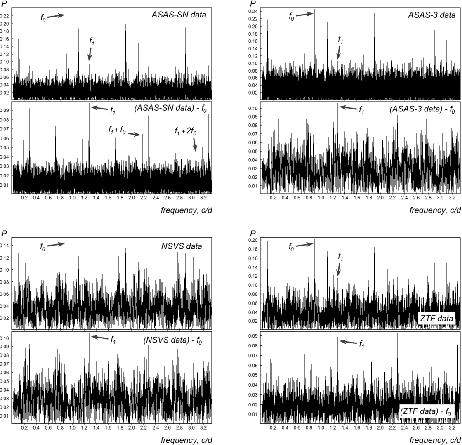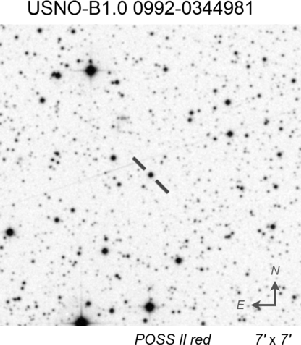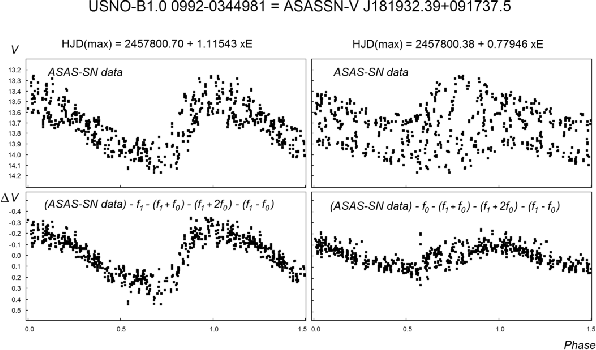|
Peremennye Zvezdy (Variable Stars) 41, No. 1, 2021 Received 19 February; accepted 9 March. |
Article in PDF |
|
DOI: 10.24412/2221-0474-2021-41-1-5
|
USNO-B1.0 0992-0344981, a New Double-mode Type-II Cepheid
A. V. Khruslov1,2
- Sternberg Astronomical Institute, Moscow State University,
Universitetsky pr. 13, 119992, Moscow, Russia; e-mail:
khruslov@bk.ru
- Institute of Astronomy, Russian Academy of Sciences, Pyatnitskaya Str. 48, 119017, Moscow, Russia
| I present a detection of a new double-mode type II Cepheid (BL Her type), USNO-B1.0 0992-0344981, pulsating in the fundamental and first-overtone modes. It is the fifth case in the Galaxy of stars of this type. For the analysis, I used all observations available for the star in the ASAS-SN, ASAS-3, NSVS, and ZTF online public archives. Light elements and parameters of the light curves were obtained. |
1. Introduction
Recently, the OGLE group identified a new group of double-mode
type-II Cepheids in our Galaxy. First, Smolec et al. (2018)
detected two BL Her-type Cepheids, pulsating in the fundamental
and first-overtone modes, OGLE-BLG-T2CEP-209 (
![]() ,
,
![]() ) and OGLE-BLG-T2CEP-0749 (
) and OGLE-BLG-T2CEP-0749 (
![]() ,
,
![]() ). Two more stars of this type were later
discovered by Udalski et al. (2018): OGLE-GD-T2CEP-0045 (
). Two more stars of this type were later
discovered by Udalski et al. (2018): OGLE-GD-T2CEP-0045 (
![]() ,
,
![]() ) and OGLE-BLG-T2CEP-1041 (
) and OGLE-BLG-T2CEP-1041 (
![]() ,
,
![]() ). For one of these stars,
OGLE-BLG-T2CEP-209 = V5864 Sgr, the first correct interpretation
of its multiperiodicity as a variable with the fundamental and
first-overtone oscillations was gives by the author (Khruslov,
2015). Previously, the star was classified by Soszynski et al.
(2011) as a BL Her variable star with the primary period
1
). For one of these stars,
OGLE-BLG-T2CEP-209 = V5864 Sgr, the first correct interpretation
of its multiperiodicity as a variable with the fundamental and
first-overtone oscillations was gives by the author (Khruslov,
2015). Previously, the star was classified by Soszynski et al.
(2011) as a BL Her variable star with the primary period
1![]() 1812838 and three additional periods, 0
1812838 and three additional periods, 0![]() 83298,
0
83298,
0![]() 48851, 0
48851, 0![]() 34559. Khruslov (2015) interpreted the
oscillations (besides the two main ones) as interaction
frequencies and detected 10 interaction frequencies in his
analysis of the OGLE data. However, the variable was re-classified
as a Classical Cepheid without sufficient justification.
34559. Khruslov (2015) interpreted the
oscillations (besides the two main ones) as interaction
frequencies and detected 10 interaction frequencies in his
analysis of the OGLE data. However, the variable was re-classified
as a Classical Cepheid without sufficient justification.
According to the AAVSO VSX database1, these four cases are currently all the known variables of this type. The VSX classified the stars as CWB(B) type variables.
In this paper, I present a detection of a new double-mode type II (BL Her type) Cepheid pulsating in the fundamental and first-overtone modes, USNO-B1.0 0992-0344981.
For my analysis, I used all observations available for the star in the following online public photometric archives: the All-Sky Automated Survey for Supernovae (ASAS-SN2; Shappee et al., 2014; Kochanek et al., 2017); the All Sky Automated Survey (ASAS-33; Pojmanski, 2002), the Northern Sky Variability Survey (NSVS4, Wozniak et al., 2004); and the Zwicky Transient Facility Catalog of Periodic Variable Stars (ZTF5; Chen et al., 2020).
The star was identified in the USNO-B1.0 (Monet et al., 2003) catalog. The coordinates of the variable were drawn from the Gaia DR2 catalog (Gaia Collaboration, Brown et al., 2018). The photometric data used in my study are available online in the html version of this paper as a zip-archive. Figure 1 presents the finding chart of USNO-B1.0 0992-0344981.
2. Variability
The variability of USNO-B1.0 0992-0344981, RA(J2000) =
18![]() 19
19![]() 32
32![]() 39, Dec(J2000) = +09
39, Dec(J2000) = +09![]() 17
17![]() 37
37
![]() 5, was
announced in the ASAS-SN Catalog of Variable Stars (Jayasinghe et
al., 2018). The star was designated as ASASSN-V
J181932.39+091737.5. The variable was classified as a BL Her-type
Cepheid, type CWB (the variability type according to the GCVS
classifications system, Samus et al., 2017). The light elements
are: HJD(max)
5, was
announced in the ASAS-SN Catalog of Variable Stars (Jayasinghe et
al., 2018). The star was designated as ASASSN-V
J181932.39+091737.5. The variable was classified as a BL Her-type
Cepheid, type CWB (the variability type according to the GCVS
classifications system, Samus et al., 2017). The light elements
are: HJD(max)
![]() ; the mean
magnitude is 13
; the mean
magnitude is 13![]() 73; and the amplitude is 0.63 in Johnson's
73; and the amplitude is 0.63 in Johnson's ![]() band. The AAVSO VSX gives different light elements: HJD(max)
band. The AAVSO VSX gives different light elements: HJD(max)
![]() , with the reference to the
same publication.
, with the reference to the
same publication.
I noticed a strong scattering of the phased light curve and suspected multi-periodicity. I analyzed all the observations using Deeming's method (Deeming, 1975) implemented in the WinEfk6 code written by V.P. Goranskij. Two components of the star's variability were detected using ASAS-SN, ASAS-3, NSVS, and ZTF data.
Power spectra of the variable according to all analyzed data, for the raw data and after subtraction of the fundamental-mode oscillation, are shown in Fig. 2. In all the panels, the structure of the power spectra shows that the secondary periods are real.
 |
Fig. 2. The power spectra of USNO-B1.0 0992-0344981 according to ASAS-SN, ASAS-3, NSVS, and ZTF data. |
Our study shows that the variable is pulsating in the fundamental
and first-overtone modes. USNO-B1.0 0992-0344981 is a double-mode
BL Her-type Cepheid, type CWB(B). In addition to the two main
modes, I detected three interaction frequencies: ![]() ,
, ![]() , and
, and ![]() .
.
Table 1 presents the light elements of all oscillations (the period and epoch of maximus) and semi-amplitudes of the oscillations according to ASAS-SN data. To improve the light elements of fundamental and first-overtone oscillations, ASAS-3 and NSVS data were used.
| Mode | Period, days | Epoch, HJD | Semi-amplitude, mag |
| 1.11543 | 2457800.70 | 0.259 | |
| 0.77946 | 2457800.38 | 0.098 | |
| 0.45885 | 2457800.445 | 0.073 | |
| 0.32511 | 2457800.185 | 0.040 | |
| 2.588 | 2457801.15 | 0.032 |
The period ratio,
![]() , is close to
, is close to ![]() , which is
typical for pulsations in the fundamental and first-overtone modes
(Petersen, 1973).
, which is
typical for pulsations in the fundamental and first-overtone modes
(Petersen, 1973).
The color indices are: ![]() (2MASS; Skrutskie et al.,
2006);
(2MASS; Skrutskie et al.,
2006); ![]() (APASS7). The
range of variability is
(APASS7). The
range of variability is
![]() in the
in the ![]() band. We
found the asymmetry parameters to be
band. We
found the asymmetry parameters to be
![]() for the
fundamental mode,
for the
fundamental mode,
![]() for the first-overtone mode.
The light curves of USNO-B1.0 0992-0344981 according to ASAS-SN
data are displayed in Fig. 3.
for the first-overtone mode.
The light curves of USNO-B1.0 0992-0344981 according to ASAS-SN
data are displayed in Fig. 3.
3. Discussion
Udalski et al. (2018) noted that, in the Petersen diagram, the
group of double-mode BL Her stars is located out of the sequence
of fundamental and first-overtone multi-mode classical Cepheids
(it is substantially below them). This group is characterized by
the following parameters: the fundamental pulsation periods are
close to one day and the period ratio, ![]() , is close to
0.70. The parameters of the known OGLE CWB(B) stars are:
, is close to
0.70. The parameters of the known OGLE CWB(B) stars are:
![]() ;
;
![]() ; the absolute value of
the Galactic latitude (
; the absolute value of
the Galactic latitude (![]() ) does not exceed
) does not exceed
![]() .
.
The fundamental period of USNO-B1.0 0992-0344981 is within this
interval. The period ratio is close to that for known CWB(B)
variables, however it is slightly smaller, additionally increasing
the distance of the star from the F/1O Cepheid sequence in the
Petersen diagram. USNO-B1.0 0992-0344981 is located at a larger
distance from the Galactic plane compared to other known CWB(B)
stars of OGLE, its galactic latitude is
![]() , which makes
it more reasonable to suggest that the variable is in the Galactic
halo as a representative of population II Cepheids of the BL Her
type.
, which makes
it more reasonable to suggest that the variable is in the Galactic
halo as a representative of population II Cepheids of the BL Her
type.
USNO-B1.0 0992-0344981 increases the sample of known double-mode type II Cepheid stars to five.
Acknowledgments: The author is grateful to Dr.
V.P. Goranskij for providing his light-curve analysis software.
References:
Chen, X., Wang, S., Deng, L., et al., 2020, Astrophys. J. Suppl., 249, Issue 1, id. 18
Deeming, T.J., 1975, Astrophys.&Space Sci., 36, 137
Gaia Collaboration, Brown, A.G.A., Vallenari, A., Prusti, T., et al., 2018, Astron. & Astrophys., 616, id. A1
Jayasinghe, T., Kochanek, C.S., Stanek, K.Z., et al., 2018, Mon. Not. Roy. Astron. Soc., 477, 3145
Khruslov, A.V., 2015, Perem. Zvezdy Prilozh., 15, No. 9
Kochanek, C.S., Shappee, B.J., Stanek, K.Z., et al., 2017, Publ. Astron. Soc. Pacific, 129, 104502
Monet, D.G., Levine, S.E., Canzian, B., et al., 2003, Astron. J., 125, 984
Petersen, J.O., 1973, Astron.&Astrophys., 27, 89
Pojmanski, G., 2002, Acta Astron., 52, 397
Samus, N.N., Kazarovets, E.V., Durlevich, O.V., Kireeva, N.N., Pastukhova, E.N., 2017, Astron. Rep., 61, 80
Shappee, B.J., Prieto, J.L., Grupe, D., et al., 2014, Astrophys. J., 788, 48
Skrutskie, M.F., Cutri, R.M., Stiening, R., et al., 2006, Astron. J., 131, 1163
Smolec, R., Moskalik, P., Plachy, E., et al., 2018, Mon. Not. Roy. Astron. Soc., 481, 3724
Soszynski, I., Udalski, A., Pietrukowicz, P., et al., 2011, Acta Astron., 61, 285
Udalski, A., Soszynski, I., Pietrukowicz, P., et al., 2018, Acta Astron., 68, 315
Wozniak, P. R., Vestrand, W.T., Akerlof, C.W., et al. 2004, Astron. J., 127, 2436

